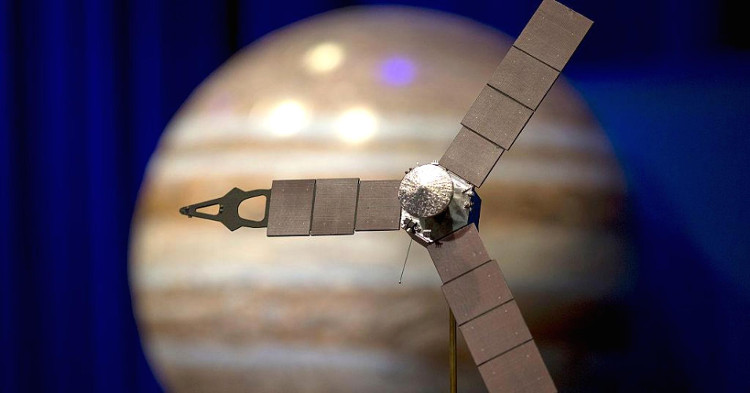Tomorrow, NASA satellite officially approached Jupiter
This giant planet still has countless mysteries that need answers.
At 22:00 today, July 4 in the US (ie 10 am 5/7 in Vietnam time), NASA's Juno unmanned space shuttle will approach Jupiter closer than any other ship. Any cylinder before. Juno has been flying more than 1.7 billion miles over the past 5 years. And today, this probe has begun to execute a series of executive commands to bring it to Jupiter's atmospheric cloud.
The engine will switch to accessibility mode. The ship will start burning fuel to slow down the movement speed so that Juno can follow the path of Jupiter. If successful, this $ 1.1 billion mission will provide the most complete data scientists to date about Jupiter, the most mysterious planet in the solar system.
Covered mainly by gas elements, Jupiter will certainly not have the same type of solid rock surface as other planets like Mars or Earth.

The photo simulates Juno's approach to Jupiter's atmosphere.(Photo source: CNBC).
"With the advancement of science and technology that people have, we really hope to discover the secrets deep inside this planet and its strata structure ," according to The words of Curt Niebur, who led the "New Horizon" program overseeing the Juno spacecraft at NASA.
Jupiter is a very strange planet. Scientists have been debating for a long time about what really exists beneath Jupiter's thick clouds. Besides, the size of Jupiter is unusually large. If you bring all the planets in the solar system and put them together, it's only half the size of Jupiter.
Jupiter has a diameter 11 times longer than Earth and it takes up to 12 years to spin all around the Sun. However, its movement speed is faster than Earth and the time Jupiter spins around the shaft takes only 10 hours. Jupiter has four large moons and several small moons surrounded.
Although it is covered in a thick layer of gas, some scientists still believe that Jupiter exists a solid core."However, so far, we don't have any real data to prove this theory," Niebur said. Besides, the formation of Jupiter is also a mystery. How unique was its thick, thick gas layer in the past? "We are waiting for an answer to be sent from Juno".
Scientists believe that, during the initial formation of the solar system, the size of Jupiter is not unusually large. To learn about this, the Juno probe will seek the presence of water and certain compounds, such as ammonia.

Juno satellite.
Jupiter stands out by a chaotic atmosphere of colored clouds . It is a planet with a beautiful color and it changes every hour.
The planet is made up mainly of helium and hydrogen . Scientists believe that, when deposited deep down in the atmosphere, under tremendous pressure and temperature, hydrogen gas will condense to a form of metal-like material. "It is neither a solid nor a liquid or gas. This form of matter combines all three characteristics," Niebur said.
The very existence of this type of hydrogen metal that Jupiter has an extremely terrible magnetic field. This magnetic field is so big that we can even see with the naked eye when viewed from the Earth.
Once approaching the outside of Jupiter's atmosphere, Juno will spend the next few months taking measurements of the magnetic field, the concentration of different chemicals and taking pictures sent to Earth. After that, Juno will pass 3000km thick of Jupiter's atmosphere to gather deeper information. In the end, Juno will gradually disintegrate due to the harsh environment in Jupiter's heart.
- The Juno ship first approached Jupiter since flying into orbit
- NASA published a detailed photograph of Jupiter's southernmost surface sent by Juno
- For the first time, humans can discover Jupiter's deepest mystery
- NASA's concussion detection: There is life on Jupiter's satellite
- Discover 10 more microscopic satellites orbiting Jupiter
- NASA wants to land on Jupiter's Europa satellite
- Juno spacecraft successfully approached Jupiter for the third time
- The Juno probe sends the first image of Jupiter to Earth
- NASA prepares a new mission to Jupiter
- The Juno probe successfully approached super typhoon on Jupiter
- NASA spotted a black spot on Jupiter nearly 4,000km long
- A series of wonderful images of Jupiter are sent from the Juno-NASA ship
 Van Allen's belt and evidence that the Apollo 11 mission to the Moon was myth
Van Allen's belt and evidence that the Apollo 11 mission to the Moon was myth The levels of civilization in the universe (Kardashev scale)
The levels of civilization in the universe (Kardashev scale) Today Mars, the sun and the Earth are aligned
Today Mars, the sun and the Earth are aligned The Amazon owner announced a secret plan to build a space base for thousands of people
The Amazon owner announced a secret plan to build a space base for thousands of people